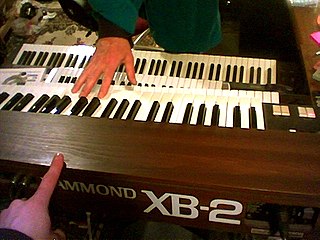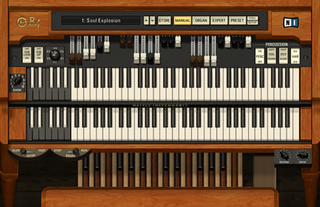
The Hammond organ is an electric organ invented by Laurens Hammond and John M. Hanert and first manufactured in 1935. Multiple models have been produced, most of which use sliding drawbars to vary sounds. Until 1975, Hammond organs generated sound by creating an electric current from rotating a metal tonewheel near an electromagnetic pickup, and then strengthening the signal with an amplifier to drive a speaker cabinet. The organ is commonly used with the Leslie speaker.

An electronic keyboard, portable keyboard, or digital keyboard is an electronic musical instrument based on keyboard instruments. Electronic keyboards include synthesizers, digital pianos, stage pianos, electronic organs and digital audio workstations. In technical terms, an electronic keyboard is a synthesizer with a low-wattage power amplifier and small loudspeakers.

An electric organ, also known as electronic organ, is an electronic keyboard instrument which was derived from the harmonium, pipe organ and theatre organ. Originally designed to imitate their sound, or orchestral sounds, it has since developed into several types of instruments:

A MIDI controller is any hardware or software that generates and transmits Musical Instrument Digital Interface (MIDI) data to MIDI-enabled devices, typically to trigger sounds and control parameters of an electronic music performance. They most often use a musical keyboard to send data about the pitch of notes to play, although a MIDI controller may trigger lighting and other effects. A wind controller has a sensor that converts breath pressure to volume information and lip pressure to control pitch. Controllers for percussion and stringed instruments exist, as well as specialized and experimental devices. Some MIDI controllers are used in association with specific digital audio workstation software. The original MIDI specification has been extended to include a greater range of control features.

A sound module is an electronic musical instrument without a human-playable interface such as a piano-style musical keyboard. Sound modules have to be operated using an externally connected device, which is often a MIDI controller, of which the most common type is the musical keyboard. Another common way of controlling a sound module is through a sequencer, which is computer hardware or software designed to record and playback control information for sound-generating hardware. Connections between sound modules, controllers, and sequencers are generally made with MIDI, which is a standardized interface designed for this purpose.

A manual is a musical keyboard designed to be played with the hands, on an instrument such as a pipe organ, harpsichord, clavichord, electronic organ, melodica, or synthesizer. The term "manual" is used with regard to any hand keyboard on these instruments to distinguish it from the pedalboard, which is a keyboard that the organist plays with their feet. It is proper to use "manual" rather than "keyboard", then, when referring to the hand keyboards on any instrument that has a pedalboard.

Bass pedals are an electronic musical instrument with a foot-operated pedal keyboard with a range of one or more octaves. The earliest bass pedals from the 1970s consisted of a pedalboard and analog synthesizer tone generation circuitry packaged together as a unit. The bass pedals are plugged into a bass amplifier or PA system so that their sound can be heard. Since the 1990s, bass pedals are usually MIDI controllers, which have to be connected to a MIDI-compatible computer, electronic synthesizer keyboard, or synth module to produce musical tones. Some 2010s-era bass pedals have both an onboard synth module and a MIDI output.

A stage piano is an electronic musical instrument designed for use in live performances on stage or in a studio, as well as for music recording in jazz and popular music. While stage pianos share some of the same features as digital pianos designed for home use and synthesizers, they have a number of features which set them apart. Stage pianos usually provide a smaller number of sounds, with these being of higher quality than the ones found on regular digital pianos and home synthesizers.

A MIDI keyboard or controller keyboard is typically a piano-style electronic musical keyboard, often with other buttons, wheels and sliders, used for sending MIDI signals or commands over a USB or MIDI 5-pin cable to other musical devices or computers. MIDI keyboards lacking an onboard sound module cannot produce sounds themselves, however some models of MIDI keyboards contain both a MIDI controller and sound module, allowing them to operate independently. When used as a MIDI controller, MIDI information on keys or buttons the performer has pressed is sent to a receiving device capable of creating sound through modeling synthesis, sample playback, or an analog hardware instrument. The receiving device could be:

A clonewheel organ is an electronic musical instrument that emulates the sound of the electromechanical tonewheel-based organs formerly manufactured by Hammond from the 1930s to the 1970s. Clonewheel organs generate sounds using solid-state circuitry or computer chips, rather than with heavy mechanical tonewheels, making clonewheel organs much lighter-weight and smaller than vintage Hammonds, and easier to transport to live performances and recording sessions.

The Nord Electro is a series of electronic keyboards, developed in Sweden by Clavia, that digitally emulate electro-mechanical keyboards, such as electric pianos and electronic organs, while designed to be highly portable.
The Nord Stage is a digital keyboard or stage piano, manufactured by Clavia Digital Music Instruments of Stockholm, Sweden. There have been six editions of the instrument: the original Nord Stage in 2005, the Nord Stage EX in 2008, the Nord Stage 2 in 2011, the Nord Stage 2 EX in 2015, the Nord Stage 3 in 2017, and the Nord Stage 4 in 2023.

The Vox Continental is a transistorised combo organ that was manufactured between 1962 and 1971 by the British musical equipment manufacturer Vox. It was designed for touring musicians and as an alternative to the heavy Hammond organ. It supports drawbars in a similar manner to the Hammond, and has distinctive reverse-coloured keys. The sound is generated by a series of oscillators, using a frequency divider to span multiple octaves.

The Roland VK-7 is an electronic keyboard introduced in 1997 which simulates the sound of an electromechanical Hammond organ. Like other electronic musical instruments that emulate the sound of the electromechanical tonewheel-based organs formerly manufactured by Hammond, the VK-7 is referred to as a clonewheel organ. Currently it is replaced by the VK-8 and the VK-88.

The B4 Organ II is a discontinued commercial, proprietary software synthesizer made by Native Instruments. The software runs as a stand-alone executable, or as a VST, DXi, or RTAS plugin in a Digital audio workstation. The software is an example of a "Clonewheel organ", an attempt at recreating the sound of a Hammond organ using software synthesis.

The Kronos is a music workstation manufactured by Korg that combines nine different synthesizer sound engines with a sequencer, digital recorder, effects, a color touchscreen display and a keyboard. Korg's latest flagship synthesizer series at the time of its announcement, the Kronos series was announced at the winter NAMM Show in Anaheim, California in January 2011.

The Clavia Nord C1, Nord C2, Nord C2D are digital keyboards aimed at emulating various vintage organs. The Nord C1 was released in 2007, aimed mainly at the "gigging musician" as a digital replacement for the Hammond, Vox and Farfisa electric organs. In 2009 it was replaced by the Nord C2, which added emulation of a baroque pipe organ to widen its appeal to "churches, concert and congregation halls".

A digital accordion is an electronic musical instrument that uses the control features of a traditional accordion to trigger a digital sound module that produces synthesized or digitally sampled accordion sounds or, in most instruments, a range of non-accordion sounds, such as orchestral instruments, pipe organ, piano, guitar, and so on. Digital accordions typically encode and transmit key presses and other input as Musical Instrument Digital Interface (MIDI) messages. Most digital accordions need to be plugged into a keyboard amplifier or PA system to hear their sounds.
The Nautilus is a music workstation manufactured by Korg, a successor to Kronos 2, which comes with Kronos' nine different synthesizer sound engines and other similar features. It was announced in November 2020 with availability in January 2021.

















